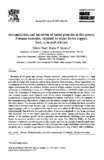Accumulation and excretion of metal granules in the prawn, Penaeus monodon, exposed to water-borne copper, lead, iron and calcium

Tingnan/
Petsa
1994Page views
840Metadata
Ipakita ang buong tala ng itemCited times in Scopus
Share
Abstract
Juveniles of the giant tiger prawn, Penaeus monodon, were exposed for 10 days to 1 mg/l copper, lead, iron or calcium in order to investigate the formation and accumulation of metal granules in major soft tissues as well as their excretion from the body. Metal deposition was investigated by histochemistry and electron microscopy in the hepatopancreas and surrounding organs and tissues like the stomach, midgut, anterior midgut caecum, thoracal antennal gland extensions, haematopoietic tissue, and interspersed musculature, connective tissue and pigment tissue. The abundance of metal granules varied greatly between the metals and the tissues. Iron and calcium deposits were found in none of the tissues investigated. Copper granules were accumulated in high quantity in the hepatopancreas tubules, were scarce in the antechamber of the hepatopancreas, the anterior midgut and the anterior midgut caecum, and were lacking in the other tissues. The amount and size of copper granules increased along the hepatopancreas tubules in accordance with the cells' age. The granules were released by discharge of senescent hepatopancreas cells in the antechamber region and were added to the faeces. Lead granules were primarily found in the thoracal extensions of the antennal gland. In the hepatopancreas they occurred only in very small quantities, and in the other organs and tissues they were absent. In the antennal gland, the lead granules were individually discharged into the gland lumen by apocrine secretion and excreted with the urine. The observed ability of Penaeus monodon to detoxify and remove metals like copper and lead by granule formation and excretion and to prevent other metals like iron from entrance into major soft tissues corroborate that decapods are no suitable organisms for a long-term biomonitoring of heavy metal pollution.
Suggested Citation
Vogt, G., & Quinitio, E. T. (1994). Accumulation and excretion of metal granules in the prawn, Penaeus monodon, exposed to water-borne copper, lead, iron and calcium. Aquatic Toxicology , 28(3-4), 223-241. https://doi.org/10.1016/0166-445X(94)90035-3
Paksa
Taxonomic term
Mga koleksyon
- AQD Journal Articles [1249]
Related items
Showing items related by title, author, creator and subject.
-
Regional survey of heavy metals in fish and fish products: Malaysia
Nor, Azlan Md. (Marine Fisheries Research Department, Southeast Asian Fisheries Development Center, 2008)The paper presents the results of the survey that was conducted to determine the level of heavy metals namely cadmium, lead, and total mercury among the marine, freshwater and brackishwater (aquacultured) fishes in Malaysia. ... -
Regional survey of heavy metals in fish and fish products: Myanmar
Winn, U Than (Marine Fisheries Research Department, Southeast Asian Fisheries Development Center, 2008)The paper presents the results of the survey that aimed to determine the level of heavy metals namely cadmium, lead, and total mercury among fish and fish products in Myanmar. The samples that were analysed include black ... -
Regional survey of heavy metals in fish and fish products: Vietnam
Huynh Thi Ngoc Lien (Marine Fisheries Research Department, Southeast Asian Fisheries Development Center, 2008)This study was carried out to determine the residue levels of heavy metals such as cadmium, lead, and mercury to some fishes and fish products in Vietnam. The fish products that were included in the survey are black tiger ...



